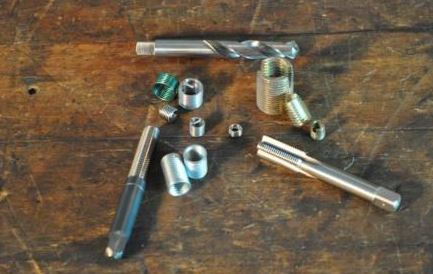
There are many not so ideal ways of fixing damaged threads by way of oversizing and cross threading; but what a lot of people don’t know is that there are many engineered solutions to properly fixing damaged threads. Even more problematic is that most people are only aware of coil based repair kits (like helicoil or permacoil).
Thread repair inserts, allow for threads to be repaired, recreated, or reinforced to the original bolt size and pitch. Solid inserts which are often made of stainless steel or carbon steel, can not only be used to repair damaged threads but also to reinforce soft base metals like aluminum to be able to take a much higher torque.
There are 2 categories of tread repair inserts:
Spring/coil based repair inserts
Solid repair inserts
Within Solid based inserts there are 2 different types of locking methodologies:
Mechanical locking
Adhesive locking
Determining which type of insert is best for your application, often comes down to cost (what doesn’t right?); the inserts that use mechanical locking methods, often need special installation tools.
Types of thread repair inserts:
Swage type (Rosan slim-serts):
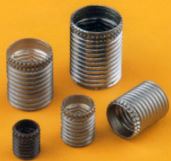
Installation: Normally use a square or six point installation drive tool to screw the insert into a freshly retapped hole, then locking the insert into place by hammering the knurling at the top of the insert into place.
Locking methodology: The insert locks into place by driving knurling at the top of the insert into the base material.
Suggested applications: Where space is an issue, these types of inserts provide the benefits of mechanical locking while being compact and lightweight, often used in aviation applications.
Self tapping (gardsert/seal-lock/ensat)
Installation: The easiest method of all, these types of inserts do not require a pretapped hole, as they create their own threads as they are installed. They also do not require special installation tools and utilize a normal nut and bolt for installation.
Locking methodology: Red loctite or other high strength adhesive suggested.
Suggested applications: Where cost is a concern; since all you need is a drill bit and no taps or special installation tools (albeit ensat has special tools available). Not recommended for applications where metal shavings could pose a problem, as there is no good way to clean out the metal shavings once the insert is installed.
Ensat:
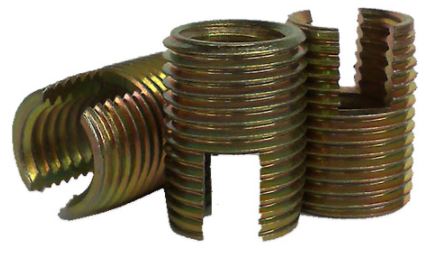
Gardsert:
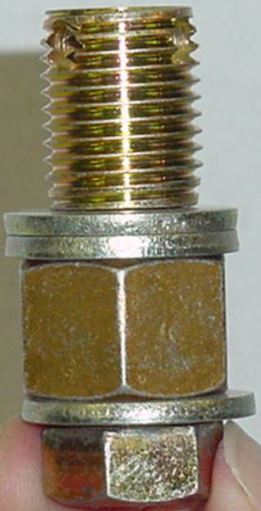
Seal-lock:
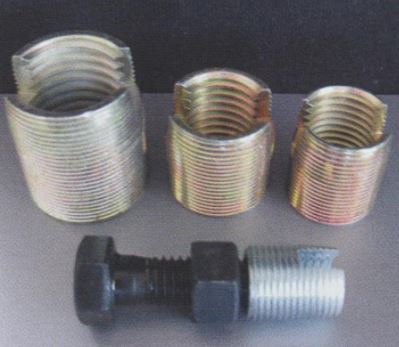
EZ Lok (loctite holding)
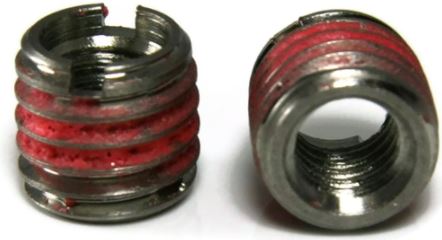
Installation: These inserts do not require special tools for installation, and can be installed easily with a screw driver. Preparation requires tapping the freshly drilled hole for the insert.
Locking methodology: Locking adhesive pre-applied to inserts, once installed the adhesive bonds the insert into the parent material.
Suggested applications: Widely available at places like Fastenal, Mcmaster-carr, and inexpensive. Suggested for none critical repairs, where ease of installation and quick availability is required.
Time-sert
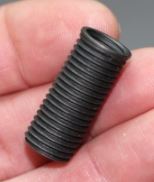
Installation: Requires drilling, tapping, chamfering, and using a special installation tool. Sold as a set for each repair size.
Locking Methodology: Mechanically locks the insert in place by way of the special installation tool forcing the treads into the base material at the base of the insert.
Suggested applications: The most expensive and involved repair method, but also the strongest. Suggested for use in critical applications such as head bolts or other applications where cost is not a concern.
Keyserts/Keensert
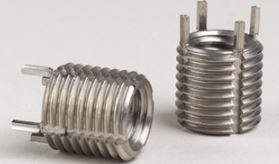
Installation: Requires drilling, tapping and uses a special tool for installation and locking the pins. The special tool can be done without in a pinch but some ingenuity may be involved in screwing in/pushing down the pins.
Locking Methodology: Once screwed in, 4 locking pins are hammered down in between the threads.
Suggested applications: Very strong mechanical insert that is relatively inexpensive, with the only limitation being that you shouldn’t use it in an application where the insert needs to seal off oil or other fluids (such as an oil drain plug). The pins allow for a slight gap where fluids could pass through.
Full Torque by Lock n Stitch

Installation: Requires drill, tapping, and uses a special set of tools for installation and jigs for locking the insert in by using a locking pin.
Locking Method: Once the insert is installed a small hole is drilled where a locking pin is driven into the threads of the insert. LocknStitch also recommends red loctite.
Suggested application: Anywhere the bottom of the insert needs to be sealed off; particularly useful in engine blocks where coolant passages may be nearby. Lock n Stitch can also make custom sizes.
Helicoil/Permacoil
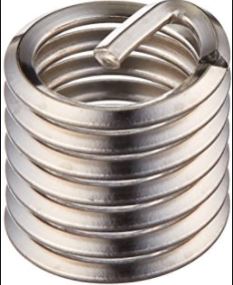
Installation: Requires drilling, tapping and using a special installation tool to install the spring type insert.
Locking Methodology: Unlike all the other inserts, this type of insert is not solid, it is essentially a spring that fits into the grooves of a freshly tapped hole. No notable locking method other than the pressure between the bolt and the spring.
Suggested applications: This is perhaps the most well known thread repair style and helicoil being the most well known brand. With the wide availability of solid inserts, I do not recommend this type of insert for any application; particularly because there is no real cost savings when comparing to something like an EZ lok or or a self tapping insert.

Thank you for all the valid informations. Like Helicoil/permacoil there is one more brand called gripcoil also are the best brands to look for.
Regatds
How much is a set of m10 by 1.5 time sert. Can I buy them alone not in a set
Good Morning, I am looking for the following tooling to install Slimsert thin wall inserts . K4SRW628-628L & K4SRW258-258L not to worried if the kit comes with the inserts as we can get those from the manufacturer but the installation tools are the most important item.
Regards
Barry
Great info. Just curious how can the self-tapping insert (gardsert/seal-lock/ensat) work under high loads or vibration? Even without the use of taps will the internal threads hold?